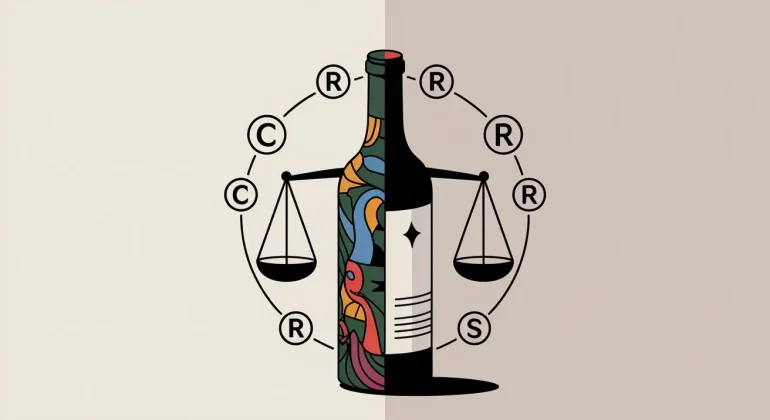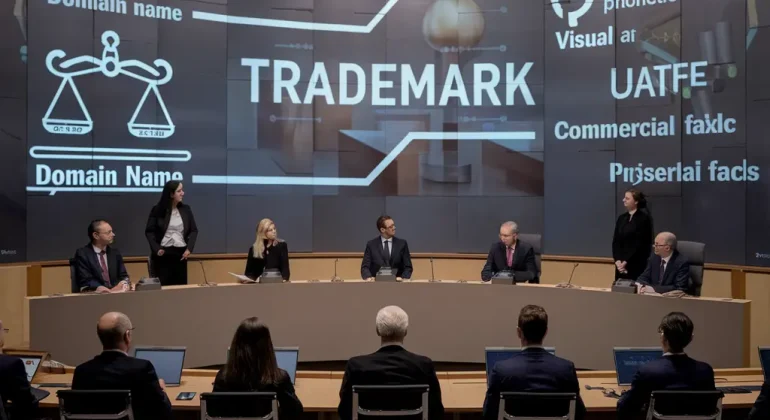Copyright and trademark in wine packaging and labeling
Key considerations for wineries and wine businesses in the United States
Wine labeling is more than just listing the varietal, region, or vintage—it’s a creative and strategic endeavor that shapes a winery’s public identity. Elements such as labels, logos, colors, fonts, taglines, and even bottle shapes can become critical assets, each subject to complex legal protections. In the United States, two primary areas of intellectual property (IP) come into play: copyright (for creative works) and trademark (for brand identifiers). When properly leveraged, these legal tools can protect a producer’s investment in design and branding, deter counterfeiters, and bolster a winery’s reputation in a crowded market.
This article delves into copyright and trademark laws as they affect the packaging and labeling of wine, highlighting the interplay with Alcohol and Tobacco Tax and Trade Bureau (TTB) regulations, and offering practical guidance for ensuring comprehensive protection of your label designs.
The importance of packaging and labeling in the wine industry
Brand differentiation and market perception
- Visual Identity: In a sector where numerous bottles vie for attention on retail shelves, your label and packaging are often the first points of consumer engagement. A carefully crafted design can influence purchasing decisions.
- Storytelling and Heritage: Many wineries infuse their labels with elements reflecting their history, terroir, or family legacy. Whether it’s a depiction of a vineyard landscape or a stylized crest passed down through generations, these creative visuals become a key part of the wine’s story.
(Stat Note: According to data from the Wine Market Council, up to 70% of wine-buying decisions are made in-store based on label appeal and perceived brand quality.)
The convergence of art and commerce
Wine labels transcend mere product description, often functioning as miniature works of art. This dual function—practical (identifying the wine) and artistic (evoking themes, emotions, stories)—can lead to overlapping legal protections under copyright law (protecting creative expression) and trademark law (protecting distinctive brand elements).
Copyright protection for wine labels and packaging
What copyright covers
Copyright in the United States protects “original works of authorship fixed in any tangible medium of expression.” For wine labels, this typically applies to:
- Illustrations, graphics, and artwork: Any unique drawings, images, or decorative elements.
- Photographs: If the label features original photography of a vineyard, estate, or other subjects.
- Textual designs: Certain stylized text arrangements that reflect creative authorship, beyond merely stating the wine’s variety or region.
Under 17 U.S.C. § 102, you automatically hold the copyright to your label from the moment it’s created in a fixed form. However, registering the work with the U.S. Copyright Office (copyright.gov) offers additional legal benefits, including the ability to seek statutory damages and attorneys’ fees if you prevail in an infringement lawsuit.
Registration benefits and best practices
- Enhanced enforcement: Registered copyrights provide a clear record of authorship and ownership.
- Public notice: By registering, you publicly assert your claim, deterring would-be infringers.
- Copyright notice: Including a notice (e.g., © [Year] [Owner Name]) on the label strengthens your position, though it is not mandatory for protection.
(Practical Tip: Some wineries register new label designs as soon as they’re finalized, particularly for high-end releases or limited-edition bottles that rely heavily on unique artwork.)
Limitations of copyright in labeling
Copyright protects creative expression, not functional or factual aspects. Consequently:
- Mandatory statements: Label elements required by TTB regulations—such as alcohol content, origin, net contents—cannot be copyrighted. They are considered functional or factual.
- Generic or descriptive terms: Words that merely name a varietal (e.g., “Cabernet Sauvignon”) or region (e.g., “Napa Valley”) are not subject to copyright protection.
Trademark protection in wine labeling and branding
Distinctive elements eligible for trademark
Trademarks can protect a wide range of “source identifiers,” such as:
- Brand names and winery names: For instance, “Silver Oak” or “Jordan Winery.”
- Logos and stylized text: A custom emblem or stylized brand wordmark.
- Taglines or slogans: Marketing phrases that help consumers identify and recall your wine.
- Bottle shapes or label configurations (Trade Dress): If they are distinctive and non-functional. For example, a uniquely shaped bottle could be considered protectable trade dress when the shape itself signifies the brand.
The role of the USPTO
In the U.S., trademark registration is handled by the United States Patent and Trademark Office (USPTO) (uspto.gov). A federal trademark registration confers:
- Nationwide protection: Deters infringers beyond your immediate region.
- Legal presumptions: Proof of ownership and exclusive rights to use the mark in connection with specified goods.
- Potential for international filing: Serves as a basis for Madrid Protocol applications via the World Intellectual Property Organization (WIPO).
Label approval vs. trademark registration
It’s crucial to distinguish between TTB label approval and USPTO trademark registration:
- TTB: Focuses on compliance with labeling regulations (alcohol content, origin, disclaimers). Approval does not guarantee any IP rights in the brand name or artwork.
- USPTO: Examines distinctiveness, likelihood of confusion, and existing prior rights. A name greenlit by TTB might still face refusal or opposition at the USPTO if similar marks exist.
(Example: A wine label approved by TTB with the word “Sunset Ridge” could still be refused by the USPTO if “Sunset Ridge Cellars” is an existing registered trademark.)
Navigating overlaps and potential conflicts
Copyright vs. Trademark
- Copyright covers the artistic aspects—illustrations, creative text layout, or photographs.
- Trademark covers the brand name, logos, or distinct label designs recognized by consumers as indicating a particular source.
These two can coexist. For instance, a visually ornate label design can have copyright protection for its artwork and trademark protection for the brand name or a stylized logo.
Confusion with geographic terms and appellations
Wine labeling often highlights regions or appellations (e.g., Napa Valley, Sonoma Coast, Willamette Valley). While these terms may be necessary to describe the product, they generally cannot serve as trademarks if they are considered primarily geographic.
- Appellation conflicts: Groups like the Napa Valley Vintners Association actively defend the Napa name, ensuring it’s only used by wineries meeting certain AVA (American Viticultural Area) requirements.
- Deceptive marks: A label referencing a region or type of wine (e.g., “Champagne,” “Port,” or “Burgundy”) without following legal standards or sourcing may be found deceptive by the USPTO and refused registration.
Common pitfalls
- Generic or descriptive brand names: A term like “Chardonnay Reserve” is unlikely to qualify for trademark registration if it only describes the wine.
- Overreliance on disclaimers: The USPTO may require disclaimers for descriptive words—such as “Winery,” “Estate,” or “Vineyards”—to avoid granting exclusive rights over generic or descriptive terms.
- Failure to monitor: Neglecting to keep an eye on new trademark filings or unauthorized uses of your art or brand name can allow infringers to establish competing rights.
Case studies, statistics, and a hypothetical scenario
Case study: artistic label dispute
A California boutique winery, “Moonlight Cellars,” hired a freelance artist to create a highly detailed label for its new Merlot. The label featured a watercolor painting of an owl perched under a moonlit sky.
- Copyright conflict: The artist later discovered the winery had slightly modified her painting for limited-edition releases without seeking permission. She filed a copyright infringement claim.
- Trademark overlap: The winery had successfully registered “Moonlight Cellars” as a trademark but had neglected to secure permission for derivative use of the artwork.
- Outcome: Through negotiation, the winery purchased additional rights. This underscored the need for clear licensing agreements that address both the original and potential future uses of label artwork.
Stats on wine label design and IP registration
A 2025 report by the USPTO indicated that trademark applications within Class 33 (wines and spirits) rose by 12% year over year, reflecting the increasing number of independent labels and craft producers. Separately, the Graphic Artists Guild noted a 20% rise in requests for label design-related copyright registrations, emphasizing the growing commercial importance of visual identity in the wine sector.
Hypothetical client example: Golden Crest Wines
“Golden Crest Wines,” a Washington-based winery, launched a new Rosé line with a stylized gold crest design. They:
- Secured a trademark for the name “Golden Crest Wines” and the stylized crest logo via the USPTO.
- Registered the label artwork with the U.S. Copyright Office to protect the crest’s elaborate design and background art.
- Ensured TTB compliance by accurately listing the AVA and alcohol content.
- Result: A cohesive IP strategy minimized the risks of both brand confusion and unauthorized replication of the label design.
Practical tips for protecting wine packaging and labels
Use written agreements for artwork
Whenever hiring freelance designers or agencies:
- Clarify ownership: Decide whether you, as the winery, will own the full copyright upon creation, or whether the artist retains some rights.
- License scope: Define if the artwork can be used across multiple product lines, websites, or future limited editions.
- Work-for-hire provisions: In many cases, you must explicitly state that the work is “made for hire,” otherwise the artist may retain the copyright.
Conduct thorough searches before launch
- USPTO TESS: Check for existing marks that could conflict with your proposed brand name, logo, or slogans.
- Copyright Office records: If using stock imagery or previously commissioned art, ensure no overlapping claims or restrictions exist.
- Appellation guidelines: Verify any TTB or AVA requirements for wording, disclaimers, or usage permissions.
Register, monitor, and enforce
- Timely registration: File for trademark registration as soon as you decide on a brand. Similarly, register label designs or other major creative elements with the Copyright Office.
- Monitoring new filings: Watch for potential conflicts in the USPTO Official Gazette and relevant creative marketplaces (e.g., popular design platforms).
- Take swift action: If you spot an infringing label or brand name, consider sending a cease-and-desist letter or filing an opposition (for trademarks) or infringement suit (for copyright) where appropriate.
Plan for international protection
For wineries aiming to export or eventually tap into foreign markets (EU, UK, Asia, etc.):
- Trademark extension: The Madrid Protocol allows you to extend your USPTO registration internationally through WIPO (wipo.int).
- Labeling laws abroad: Investigate local regulations on disclaimers, mandatory health warnings, and protected geographical indications (like “Rioja” in Spain or “Bordeaux” in France).
Conclusion
In a competitive landscape where packaging and labeling speak volumes about your wine’s quality and origin, both copyright and trademark laws serve pivotal roles. Copyright can guard the creative essence of your label—its artwork, typography, and visual flair—while trademark secures your brand identity, ensuring that names and logos become cornerstones of consumer trust.
When carefully managed, these protections deter copycats, elevate brand perception, and may even become valuable business assets for expansions or partnerships. However, success hinges on anticipating legal hurdles, from TTB compliance to potential conflicts with existing marks or appellations.
Why work with Dreyfus?
- Recognized Expertise: With over 20 years of experience in intellectual property and a deep understanding of wine regulations, our team assists clients in creating ironclad label strategies.
- Global Network: We facilitate international registrations, ensuring that wineries eyeing overseas markets remain protected under multiple jurisdictions.
- Tailored Guidance: Each winery’s story is unique. We offer strategic advice adapted to your creative vision, marketing goals, and compliance needs.
The cabinet Dreyfus et Associés is in partnership with a worldwide network of lawyers specialized in Intellectual Property.
Ready to protect your wine’s visual identity?
- Contact us to develop a customized plan to safeguard your label and brand assets.
- Subscribe to our newsletter for the latest legal updates in wine labeling and IP.
- Download our practical guide, “5 Essential Tips for Copyright and Trademark Protection in Wine Labeling,” featuring case studies and checklists.
Additional Resources
- USPTO: uspto.gov
- TTB: ttb.gov
- U.S. Copyright Office: copyright.gov
- WIPO: wipo.int
- Graphic Artists Guild: graphicartistsguild.org
Shape your wine’s story with confidence—fortify your labels and packaging using robust legal frameworks.








